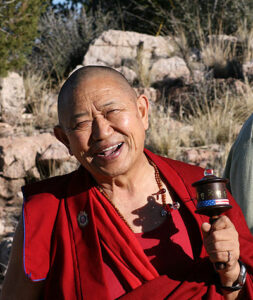Empowerments, Vows, and Sacred Commitments
The master is its depository, and the disciple will gain it by the practice of the yidams and recitation of their mantras. In order for this force and its vector-yidam-to be transmitted from the master to the disciple, a particular ceremony is necessary, the empowerment. The Tibetan tradition offers a great number of yidams, and the empowerments are numerous and varies. This varieties does not alter the essential unity of grace. It is a little like pure water that am be given and drunk in various containers. The subjed of empowerments has already been introduced in the chapter concerning the principles of the Vajrayana. It is resumed here with more detail and rompleted with an important statement on commitments derived from empowerments. These commitments themselves are placed in the general rontext of the vows.
EMPOWERMENTS
A sacred investiture The notion of empowerment implies the idea of conceding that there is a power, an authority. In the political domain, heads of State, ministers, or other governing persons occupy positions of responsibility that confer certain authority on them. To be able to hold power, it is necessary, first of all, for these people to have been invested with that power. According to their respective cultures, they have been appointed, elected, or enthroned. For example, if it concerns a coronation, the future king will be placed on a throne in the presence of dignitaries. The different emblems of royalty will be given to him and, from then on, he will be the real chief of his kingdom. Only after this investiture will the king have the authority that allows him to direct, give orders, and be obeyed by all. In the same way, an empowerment including subsections such as vase empowerment, secret empowerment, wisdom-knowledge empowerment, and precious word empowerment confers on those who receive it a power in the practice of meditation.
Vase empowerment
The first subsection within the process of empowerment is the vase empowerment, conferred on the body. It implies a relationship with different deities, in particular the five masculine Buddhas, the five feminine Buddhas, and various groups of feminine and masculine bodhisattvas. Because of this relation, the vase empowerment bestows the power to meditate on the impure aspects of the individual and the universe in their pure form, corresponding to deities, and to realize them as such.
The five aggregates-forms, sensations, perceptions, volitions, and consciousnesses-are only the reflection, within the ordinary person, of the five masculine Buddhas in the domain of Awakening.
The five aggregates-forms, sensations, perceptions, volitions, and consciousnesses-are only the reflection, within the ordinary person, of the five masculine Buddhas in the domain of Awakening. The vase empowerment introduces us to the divine essence of the five aggregates and confers on us the power to realize this essence on the basis of an equivalence between each aggregate and each Buddha.
- forms – Vairocana
- sensations – Ratnasambhava
- perceptions – Amitabha
- volitions – Amoghasiddhi
- consciousnesses – Akshobya
In the same way, an equivalence is established between the five elements and their essence, the five feminine Buddhas, to which the empowerment serves as introduction.
- earth – Buddhalocana
- water – Mamaki
- fire – Pandaravasini
- air – Samayatara
- space – Vajradhatvesvari
The eight consciousnesses-visual, auditory, olfactory, gustatory, tactile, and mental consciousnesses to which are added disturbed consciousness and the potential of consciousness (Sanskrit, alayavijnana)-are perceived as the eight great masculine Bodhisattvas, and the objects of consciousnesses as the eight great feminine Bodhisattvas.
Third, the eight consciousnesses-visual, auditory, olfactory, gustatory, tactile, and mental consciousnesses to which are added disturbed consciousness and the potential of consciousness (Sanskrit, alayavijnana)-are perceived as the eight great masculine Bodhisattvas, and the objects of consciousnesses as the eight great feminine Bodhisattvas. In this way, all psycho-physical constituents of the person are consecrated as deities. The disciple receives therefore the power to meditate visualizing himself or herself in the form of the body of the deity’s empowerment.
This process is the vase empowerment, also called, body empowerment of the deity. It is related to subtle channels (nadis) allowing the disciple to ultimately actualize the body of emanation.
Secret empowerment
In the subtle channels of the body circulates a subtle energy (prana) that is linked with speech and whose totally pure expression corresponds to the body of perfect experience (sambhogakaya). To achieve this purity, the secret empowerment is conferred. It is also called speech empowerment of the deity. Thanks to this empowerment, all impure subtle winds are transformed into pure winds.
To undertake this purification, exercises on winds and recitation of mantras are used. By this secret empowerment, the disciple receives the power to consider all sounds as the deity’s mantra. It is necessary to know that the body is innervated by a system of 72,000 nadis. The three main ones are the central channel and the two lateral channels, which flank the central channel on the right and left sides. The final part of each of these channels presents a configuration associated with the thirty consonants and sixteen vowels of the Sanskrit alphabet and forms the basis for speech to function.
When the secret empowerment is conferred, by reason of the relationship between subtle winds, speech, and sambhogakaya, the ability of actualizing the vajra speech of sambhogakaya is given.
Wisdom-knowledge empowerment
Thirdly, the deity’s mind or wisdom-knowledge empowerment is conferred on the disciple’s mind. This third empowerment is related to the tigles (Sanskrit, bindu) and confers the power of implementing meditation techniques using the tigles.
Consequently, once the vase empowerment, the secret empowerment, and wisdom-knowledge empowerment are received, it is possible to practice the Six Dharmas of Naropa. The Six Dharmas are tumo, illusory body, dream, clear light, transfer of consciousness, and bardo, during which one meditates on channels, winds, and tigles. In some cases, this presents an opportunity to practice, within the framework of the Vajrayana, techniques of retention of the tigles in sexual union.
To summarize, we have now seen the three empowerments that gather the body, speech, and mind of the lama and yidam. We have received the power to effectively meditate on the three vajras. – nadis as vajra-body – prana as vajra-speech – tigles as vajra-mind. Empowerment of the precious word or oral empowerment The fourth empowerment is the empowerment of the precious word. It relies on the principle that nadis, prana, and tigles and the totality of inner and outer phenomena proceed only from the mind. By the fourth empowerment, one is introduced to this nature of the mind, and one receives the power to practice and achieve mahamudra.
– Kalu Rinpoche–Secret Buddhism/Vajrayana Practices




